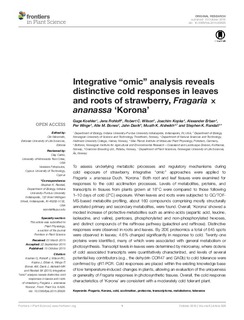| dc.contributor.author | Koehler, Gage | |
| dc.contributor.author | Rohloff, Jens | |
| dc.contributor.author | Wilson, Robert Charles | |
| dc.contributor.author | Kopka, Joachim | |
| dc.contributor.author | Erban, Alexander | |
| dc.contributor.author | Winge, Per | |
| dc.contributor.author | Bones, Atle M. | |
| dc.contributor.author | Davik, Jahn | |
| dc.contributor.author | Alsheikh, Muath K | |
| dc.contributor.author | Randall, Stephen K, | |
| dc.date.accessioned | 2016-01-05T12:16:03Z | |
| dc.date.accessioned | 2016-02-12T13:34:23Z | |
| dc.date.available | 2016-01-05T12:16:03Z | |
| dc.date.available | 2016-02-12T13:34:23Z | |
| dc.date.issued | 2015 | |
| dc.identifier.citation | Frontiers in Plant Science 2015, 6(OCTOBER) | nb_NO |
| dc.identifier.issn | 1664-462X | |
| dc.identifier.uri | http://hdl.handle.net/11250/2378978 | |
| dc.description | - | nb_NO |
| dc.description.abstract | To assess underlying metabolic processes and regulatory mechanisms during cold exposure of strawberry, integrative “omic” approaches were applied to F. ananassa ‘Korona’. Analysis of leaf tissue was emphasized because of its immediate and early responses in the cold acclimation processes. Levels of metabolites, proteins, and transcripts in tissues from plants grown at 20°C were compared to those following 1 to 10 days of cold exposure. When leaves and roots were subjected to GC/TOF-MS-based metabolite profiling, about 160 compounds comprising mostly structurally annotated primary metabolites and secondary metabolites, were found. Overall, ‘Korona’ showed a modest increase of protective metabolites such as amino acids (aspartic acid, leucine, isoleucine, and valine), pentoses, phosphorylated and non-phosphorylated hexoses, and distinct compounds of the raffinose pathway (galactinol and raffinose). Distinctive responses were observed in roots and leaves. By 2DE proteomics a total of 845 spots were observed in leaves; 4.6% changed significantly in response to cold. Twenty-one proteins were identified, many of which were associated with general metabolism or photosynthesis. Transcript levels in leaves were determined by microarray, where dozens of cold associated transcripts were quantitatively characterized, and levels of several potential key contributors (e.g., the dehydrin COR47 and GADb) to cold tolerance were confirmed by qRT-PCR. Cold responses are placed within the existing knowledge base of low temperature stress change in plants, allowing an evaluation of the uniqueness or generality of Fragaria responses in photosynthetic tissues. Overall, the cold response characteristics of ‘Korona’ are consistent with a moderately cold tolerant plant. | nb_NO |
| dc.language.iso | eng | nb_NO |
| dc.rights | Navngivelse 3.0 Norge | * |
| dc.rights.uri | http://creativecommons.org/licenses/by/3.0/no/ | * |
| dc.title | Integrative “omic” analysis reveals distinctive cold responses in leaves and roots of strawberry, Fragaria × ananassa ‘Korona’ | nb_NO |
| dc.type | Journal article | nb_NO |
| dc.type | Peer reviewed | nb_NO |
| dc.date.updated | 2016-01-05T12:16:03Z | |
| dc.subject.nsi | VDP::Matematikk og naturvitenskap: 400::Basale biofag: 470::Genetikk og genomikk: 474 | nb_NO |
| dc.subject.nsi | VDP::Mathematics and natural scienses: 400::Basic biosciences: 470::Genetics and genomics: 474 | nb_NO |
| dc.subject.nsi | VDP::Matematikk og naturvitenskap: 400::Basale biofag: 470::Molekylærbiologi: 473 | nb_NO |
| dc.subject.nsi | VDP::Mathematics and natural scienses: 400::Basic biosciences: 470::Molecular biology: 473 | nb_NO |
| dc.subject.nsi | VDP::Matematikk og naturvitenskap: 400::Zoologiske og botaniske fag: 480::Plantefysiologi: 492 | nb_NO |
| dc.subject.nsi | VDP::Mathematics and natural scienses: 400::Zoology and botany: 480::Plant physiology: 492 | nb_NO |
| dc.identifier.doi | 10.3389/fpls.2015.00826 | |
| dc.identifier.cristin | 1265808 | |

